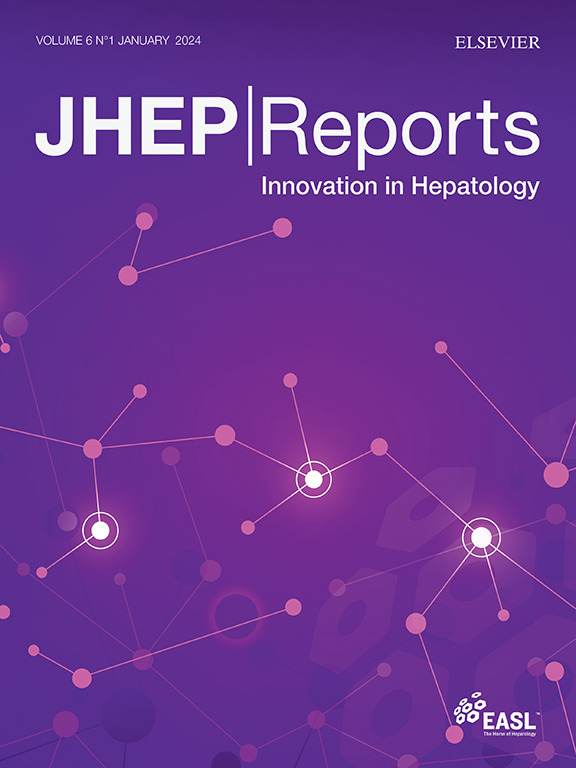TIPS植入后3个月的残余腹水较少意味着肝硬化患者的临床结果更差
IF 9.5
1区 医学
Q1 GASTROENTEROLOGY & HEPATOLOGY
引用次数: 0
摘要
背景,颈静脉肝内门体分流术(TIPS)用于肝硬化患者复发性/难治性腹水。TIPS植入后残余微量腹水的预后影响尚未研究。方法纳入维也纳(2000-2022年)和汉诺威(2009-2021年)接受有盖TIPS植入术治疗难治性腹水的肝硬化患者,并在TIPS植入术3个月(3M)后进行腹部超声检查。对患者进行进一步的失代偿和无移植死亡率随访。采用两种不同的竞争风险回归模型(调整模型I和调整模型II)来确定3M时无腹水和最小腹水对预后的影响。结果共纳入292例男性为主(71.7%),以酒精相关性肝病为主(71.7%)。在3M时,n = 105(36.0%)例患者在腹部超声检查中未发现腹水,而n = 82(28.1%)例患者表现为轻度腹水,n = 105(36.0%)例患者表现为中度/重度腹水。三组植入术后门静脉压力梯度相似(中位7 mmHg;P = 0.311)。无腹水或少量腹水的患者在基线和3M时具有终末期肝病模型和tips后生存评分的Freiburg指数。相互竞争的风险回归模型显示,最小腹水(vs.无腹水)是进一步失代偿的独立预测因子(调整模型I:调整亚分布风险比[aSHR], 1.69;95% ci, 1.03-2.77;P = 0.038;调整模型II: aSHR, 1.76;95% ci, 1.07-2.88;p = 0.026)和无移植死亡率(调整模型I: aSHR, 1.76;95% ci, 1.08-2.88;P = 0.024;调整模型II: aSHR, 1.73;95% ci, 1.05-2.82;P = 0.030)。结论:与无残余腹水的患者相比,在3M时残余少量腹水的患者仍有更高的进一步失代偿和无移植死亡风险。影响和意义本研究评估了置放TIPS后晚期慢性肝病患者残余腹水等级与预后的相关性。严重腹水与最坏的结果有关,强调了紧急肝移植评估的必要性。然而,即使是最小的残余腹水也会显著增加进一步失代偿和无移植死亡的风险。这些发现表明,残余腹水极少的患者将受益于tips后加强的临床监测。需要进一步的研究来揭示潜在的机制,并调查有针对性的干预措施的潜力,以改善这一弱势群体的结果。本文章由计算机程序翻译,如有差异,请以英文原文为准。
Minimal residual ascites 3 months after TIPS implantation implicates worse clinical outcomes in patients with cirrhosis
Background & Aims
Transjugular intrahepatic portosystemic shunt (TIPS) implantation is indicated for recurrent/refractory ascites in patients with cirrhosis. The prognostic impact of residual minimal ascites after TIPS implantation has not yet been investigated.
Methods
We included patients with cirrhosis undergoing covered TIPS implantation for refractory ascites in Vienna (2000–2022) and Hannover (2009–2021) with available abdominal ultrasound 3 months after TIPS insertion (3M). The patients were followed up for further decompensation and transplant-free mortality. Two distinct competing risk regression models (Adjusted model I and Adjusted model II) were performed to determine the prognostic impact of no vs. minimal ascites at 3M.
Results
Overall, 292 patients with male predominance (71.7%) and mostly alcohol-related liver disease (71.7%) were included. At 3M, n = 105 (36.0%) patients showed no ascites on abdominal ultrasound, whereas n = 82 (28.1%) exhibited minimal and n = 105 (36.0%) moderate/severe ascites. The portal pressure gradient after TIPS implantation was similar in the three groups (median 7 mmHg; p = 0.311). Patients with no or minimal ascites had comparable Model for End-Stage Liver Disease and Freiburg Index of Post-TIPS Survival scores at baseline and 3M. Competing risk regression models showed that minimal ascites (vs. no ascites) was an independent predictor of further decompensation (Adjusted model I: adjusted subdistribution hazard ratio [aSHR], 1.69; 95% CI, 1.03–2.77; p = 0.038; Adjusted model II: aSHR, 1.76; 95% CI, 1.07–2.88; p = 0.026) and transplant-free mortality (Adjusted model I: aSHR, 1.76; 95% CI, 1.08–2.88; p = 0.024; Adjusted model II: aSHR, 1.73; 95% CI, 1.05–2.82; p = 0.030).
Conclusions
Patients with residual minimal ascites at 3M remain at higher risk for further decompensation and transplant-free mortality compared with those with no residual ascites.
Impact and implications
This study evaluated the prognostic relevance of residual ascites grades in patients with advanced chronic liver disease after TIPS placement. Severe ascites was linked to the worst outcomes, underscoring the need for urgent liver transplantation evaluation. However, even minimal residual ascites significantly increased the risk of further decompensation and transplant-free mortality. These findings suggest that patients with minimal residual ascites will benefit from enhanced post-TIPS clinical monitoring. Further research is warranted to uncover the underlying mechanisms and investigate the potential of targeted interventions to improve outcomes in this vulnerable group.
求助全文
通过发布文献求助,成功后即可免费获取论文全文。
去求助
来源期刊

JHEP Reports
GASTROENTEROLOGY & HEPATOLOGY-
CiteScore
12.40
自引率
2.40%
发文量
161
审稿时长
36 days
期刊介绍:
JHEP Reports is an open access journal that is affiliated with the European Association for the Study of the Liver (EASL). It serves as a companion journal to the highly respected Journal of Hepatology.
The primary objective of JHEP Reports is to publish original papers and reviews that contribute to the advancement of knowledge in the field of liver diseases. The journal covers a wide range of topics, including basic, translational, and clinical research. It also focuses on global issues in hepatology, with particular emphasis on areas such as clinical trials, novel diagnostics, precision medicine and therapeutics, cancer research, cellular and molecular studies, artificial intelligence, microbiome research, epidemiology, and cutting-edge technologies.
In summary, JHEP Reports is dedicated to promoting scientific discoveries and innovations in liver diseases through the publication of high-quality research papers and reviews covering various aspects of hepatology.
 求助内容:
求助内容: 应助结果提醒方式:
应助结果提醒方式:


